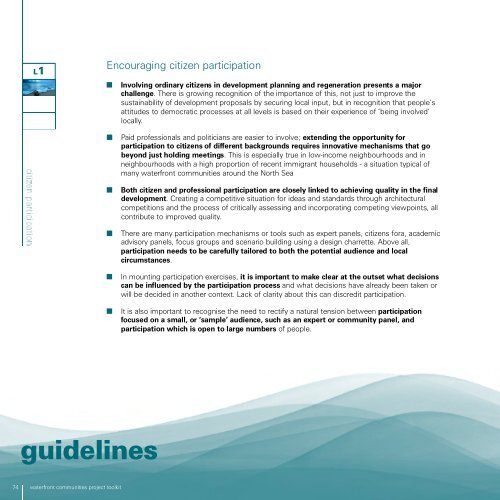citizen participation - waterfront communities project
citizen participation - waterfront communities project
citizen participation - waterfront communities project
Create successful ePaper yourself
Turn your PDF publications into a flip-book with our unique Google optimized e-Paper software.
7 4<br />
L1<br />
g u i d e l i n e s<br />
<strong>waterfront</strong> <strong>communities</strong> <strong>project</strong> toolkit<br />
Encouraging <strong>citizen</strong> <strong>participation</strong><br />
� Involving ordinary <strong>citizen</strong>s in development planning and regeneration presents a major<br />
c h a l l e n g e. There is growing recognition of the importance of this, not just to improve the<br />
sustainability of development proposals by securing local input, but in recognition that people’s<br />
attitudes to democratic processes at all levels is based on their experience of ‘being involved’<br />
l o c a l l y.<br />
� Paid professionals and politicians are easier to involve; extending the opportunity for<br />
<strong>participation</strong> to <strong>citizen</strong>s of different backgrounds requires innovative mechanisms that go<br />
beyond just holding meetings. This is especially true in low-income neighbourhoods and in<br />
neighbourhoods with a high proportion of recent immigrant households - a situation typical of<br />
many <strong>waterfront</strong> <strong>communities</strong> around the North Sea<br />
� Both <strong>citizen</strong> and professional <strong>participation</strong> are closely linked to achieving quality in the final<br />
d e v e l o p m e n t. Creating a competitive situation for ideas and standards through architectural<br />
competitions and the process of critically assessing and incorporating competing viewpoints, all<br />
contribute to improved quality.<br />
� There are many <strong>participation</strong> mechanisms or tools such as expert panels, <strong>citizen</strong>s fora, academic<br />
advisory panels, focus groups and scenario building using a design charrette. Above all,<br />
<strong>participation</strong> needs to be carefully tailored to both the potential audience and local<br />
c i r c u m s t a n c e s.<br />
� In mounting <strong>participation</strong> exercises, it is important to make clear at the outset what decisions<br />
can be influenced by the <strong>participation</strong> process and what decisions have already been taken or<br />
will be decided in another context. Lack of clarity about this can discredit <strong>participation</strong>.<br />
� It is also important to recognise the need to rectify a natural tension between p a r t i c i p a t i o n<br />
focused on a small, or ‘sample’ audience, such as an expert or community panel, and<br />
<strong>participation</strong> which is open to large numbers of people.


